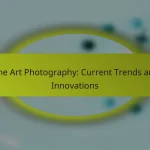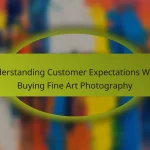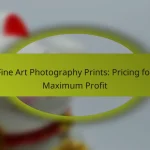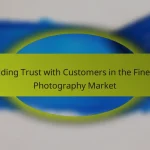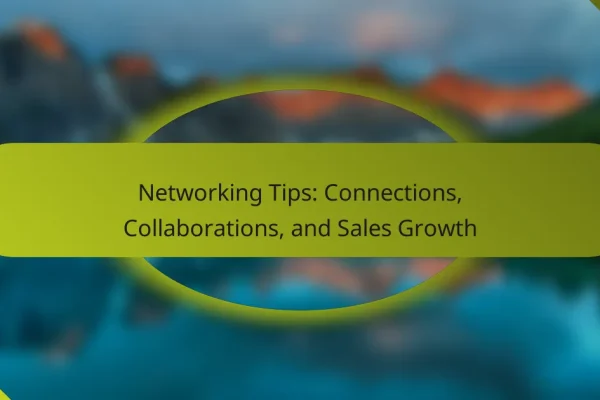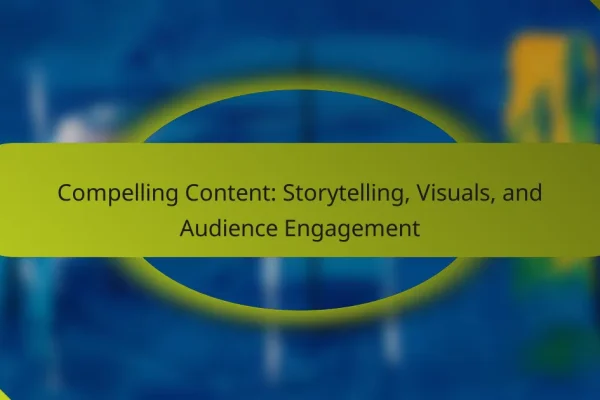What are effective marketing techniques for fine art prints?
Effective marketing techniques for fine art prints include leveraging social media, email marketing, influencer partnerships, content strategies, and online marketplaces. These methods help artists reach a broader audience, engage potential buyers, and ultimately drive sales.
Social media advertising
Social media advertising is a powerful tool for promoting fine art prints. Platforms like Instagram and Facebook allow artists to showcase their work visually, targeting specific demographics based on interests and behaviors.
To maximize impact, use high-quality images and engaging captions. Consider running targeted ads with a budget that suits your goals, starting as low as $5 per day to test different audiences and ad formats.
Email marketing campaigns
Email marketing campaigns are essential for building relationships with potential buyers. Collect email addresses through your website or social media and send regular newsletters featuring new prints, upcoming exhibitions, or exclusive offers.
Keep your emails visually appealing and concise. Aim for a frequency of once or twice a month to maintain interest without overwhelming your subscribers.
Influencer collaborations
Collaborating with influencers can significantly boost visibility for fine art prints. Identify influencers within the art community who resonate with your style and values, and propose partnerships that benefit both parties.
Consider offering them a free print in exchange for promotion or a commission on sales generated through their audience. This can create authentic endorsements and expand your reach.
Content marketing strategies
Content marketing strategies involve creating valuable content that attracts and engages your target audience. This could include blog posts about your artistic process, video tutorials, or behind-the-scenes looks at your studio.
Regularly updating your content can improve your website’s SEO, making it easier for potential buyers to find your prints online. Aim for a mix of educational and promotional content to keep your audience engaged.
Online art marketplaces
Online art marketplaces provide a platform for artists to sell their prints to a global audience. Websites like Etsy, Saatchi Art, and Artfinder allow you to set up a shop with minimal upfront costs.
Research each platform’s fees and audience to choose the best fit for your work. Consider diversifying your presence across multiple marketplaces to increase visibility and sales opportunities.
How to leverage social media for fine art print sales?
Leveraging social media for fine art print sales involves using platforms to showcase artwork, engage with potential buyers, and drive traffic to your online store. By strategically utilizing various channels, artists can effectively reach art enthusiasts and convert them into customers.
Utilizing Instagram for visual storytelling
Instagram is a powerful platform for visual storytelling, making it ideal for promoting fine art prints. Artists can share high-quality images of their work, behind-the-scenes processes, and personal stories to connect with their audience. Using relevant hashtags can further increase visibility and attract art lovers.
Consider creating a cohesive aesthetic for your Instagram feed that reflects your artistic style. Regularly posting updates and engaging with followers through comments and direct messages can foster a loyal community around your art.
Facebook ads targeting art enthusiasts
Facebook ads allow for precise targeting, enabling artists to reach specific demographics interested in art. By defining your audience based on interests, behaviors, and location, you can create tailored ads that resonate with potential buyers. This can significantly enhance your chances of making sales.
Utilize eye-catching visuals and compelling copy in your ads to draw attention. A/B testing different ad formats and messages can help determine what works best for your audience, maximizing your advertising budget.
Creating engaging TikTok content
TikTok offers a unique opportunity to create engaging short-form videos that can go viral. Artists can showcase their creative process, share tips, or even provide insights into the inspiration behind their prints. This type of content can attract a younger audience and drive interest in your artwork.
Focus on trends and challenges within the platform to increase visibility. Collaborating with other creators or participating in art-related hashtags can further enhance your reach and engagement on TikTok.
What role does SEO play in marketing fine art prints?
SEO, or Search Engine Optimization, is crucial for marketing fine art prints as it helps increase visibility in search engine results. By optimizing your online presence, you can attract more potential buyers and enhance engagement with your artwork.
Keyword optimization for art-related searches
Keyword optimization involves researching and selecting relevant terms that potential customers use when searching for art prints. Focus on specific phrases like “affordable fine art prints” or “limited edition art prints” to target your audience effectively. Tools like Google Keyword Planner can help identify popular search terms.
Incorporate these keywords naturally into your website content, including titles, descriptions, and blog posts. Aim for a balance between high-traffic keywords and niche terms that reflect your unique style, which can help you stand out in a competitive market.
Building backlinks from art blogs
Building backlinks from reputable art blogs can significantly enhance your SEO efforts. Reach out to art bloggers and offer to contribute guest posts or collaborate on projects, which can lead to links back to your site. This not only boosts your site’s authority but also drives targeted traffic.
Consider creating shareable content, such as tutorials or behind-the-scenes looks at your creative process, to encourage bloggers to link to your site. Aim for a mix of high-quality links from various sources to improve your overall search ranking.
Using alt text for print images
Alt text is essential for improving the SEO of your fine art print images. This text describes the content of an image and helps search engines understand what it depicts. Use descriptive phrases that include relevant keywords to enhance your visibility in image searches.
For example, instead of using generic alt text like “art print,” specify “abstract watercolor art print by [Your Name].” This not only aids SEO but also makes your site more accessible to users with visual impairments. Regularly review and update your alt text to reflect any changes in your artwork or marketing strategy.
How to optimize an e-commerce site for fine art prints?
To optimize an e-commerce site for fine art prints, focus on enhancing user experience and ensuring seamless transactions. Key elements include intuitive navigation, high-quality visuals, and an efficient checkout process.
Implementing user-friendly navigation
User-friendly navigation is essential for guiding potential buyers through your site. Organize categories logically, such as by artist, style, or price range, to help users find what they are looking for quickly. Incorporate a search bar that allows for keyword searches to enhance accessibility.
Consider using breadcrumb trails to show users their location within the site. This feature not only improves navigation but also encourages exploration of related artworks, potentially increasing sales.
High-quality product images and descriptions
High-quality images are crucial for selling fine art prints online, as they allow customers to appreciate the details and colors of the artwork. Use multiple images from different angles and include zoom functionality to give a closer look at the textures.
Accompany images with detailed descriptions that include the artist’s background, the inspiration behind the piece, and the materials used. This information can help create a connection between the buyer and the artwork, enhancing the likelihood of a purchase.
Streamlined checkout process
A streamlined checkout process minimizes cart abandonment and increases conversion rates. Limit the number of steps required to complete a purchase and offer guest checkout options to avoid deterring customers who do not want to create an account.
Ensure that payment options are varied and secure, accommodating different preferences such as credit cards, PayPal, or local payment methods. Display clear shipping costs and estimated delivery times to set customer expectations and enhance trust.
What are the best online platforms for selling fine art prints?
The best online platforms for selling fine art prints include Etsy and Saatchi Art, each catering to different audiences and needs. Choosing the right platform depends on your target market, the type of art you create, and your marketing strategy.
Etsy for handmade art
Etsy is a popular marketplace for handmade and vintage items, making it an ideal platform for artists selling fine art prints. It allows you to create a personalized shop, showcase your artwork, and connect directly with buyers who appreciate unique creations.
When using Etsy, focus on high-quality images and detailed descriptions to attract potential customers. Pricing your prints competitively while considering Etsy’s fees, which can range from 5% to 6.5%, is crucial for maintaining profitability.
Saatchi Art for global reach
Saatchi Art is an online gallery that provides artists with a platform to reach a global audience. It specializes in original artwork and limited edition prints, allowing you to showcase your fine art prints to collectors worldwide.
To succeed on Saatchi Art, ensure your portfolio is diverse and visually appealing. The platform takes a commission of around 35% on sales, so factor this into your pricing strategy. Additionally, leveraging Saatchi’s marketing tools can help increase visibility and drive sales.


